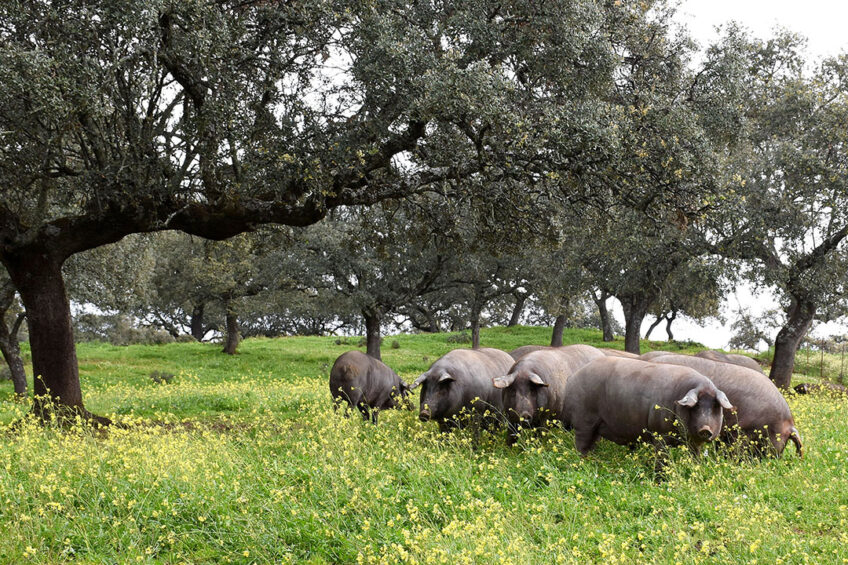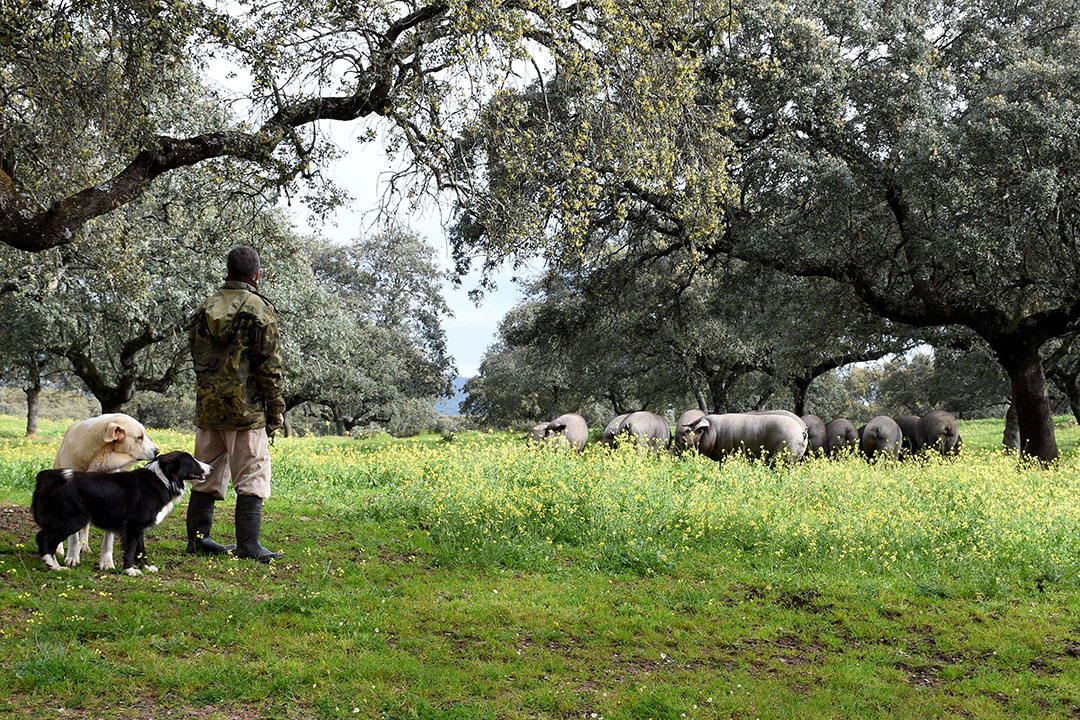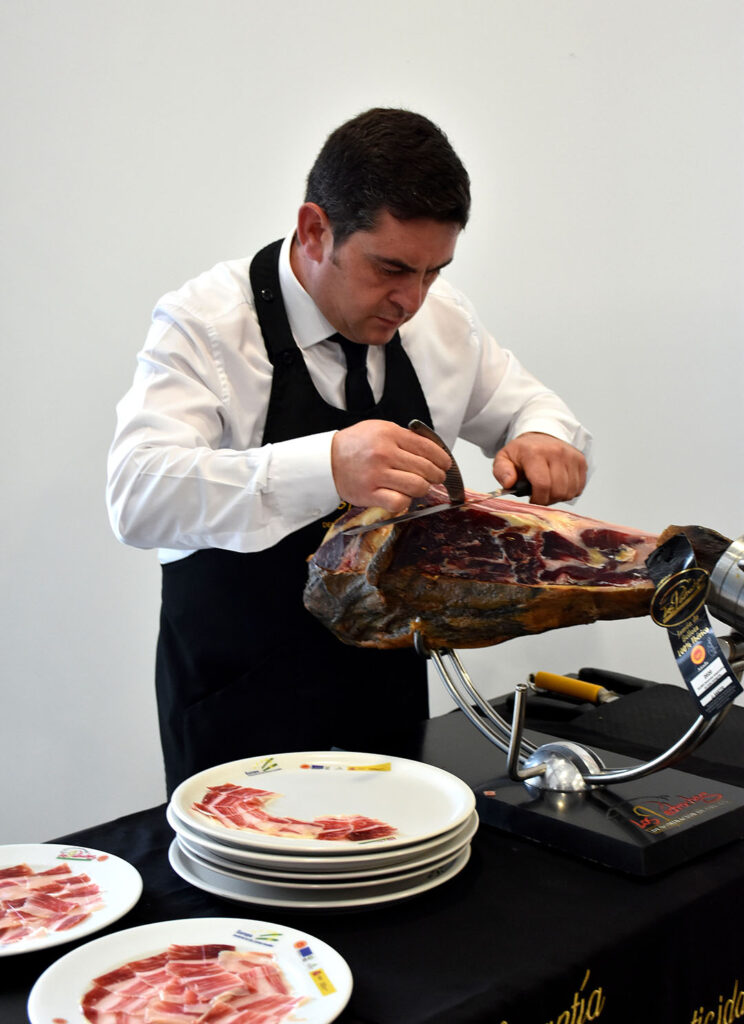The final feeding stage of Iberian pigs is key

Iberian hams are favoured by consumers all over the world due to the meat’s intense range of flavours and its high quality. It’s the feeding programme for the Black Iberian pigs, known as La Montanera, that helps influence these flavours.
As the name suggests, these pigs are reared on the Iberian Peninsula across southern Spain and Portugal, feeding outdoors on pastures full of herbs, flowers, chestnuts and acorns. Feeding on the wealth of natural food found in these pastures is what gives the special Jamon Iberico ham its unique flavour that is craved by so many. Not only is this meat tasty; it also brings with it some health properties due to its beneficial fat content, and it is protected under quality regulations. The ham’s high proportion of oleic acid, around 63%, is a mono-unsaturated fatty acid that increases ‘good’ cholesterol and reduces ‘bad’ cholesterol levels.
This type of farming is one of the most traditional methods of rearing this breed dating back to the 15th century, with many generations of Spanish farming families perfecting their very own pig genetics over time. One of those farmers, Fernando Adell, 64, not only rears Iberian pigs; he also owns the family business, the Dehesa de Campo Alta processing facility in the north of the Cordoba province, close to Espiel.
On his farm, which is only 15 minutes from the processing unit, Fernando runs 400 pigs across 700 hectares that enjoy a long healthy life before being slaughtered at 18 to 24 months old.
Their meat is then matured for up to 4 years in salt before it is harvested by a master carver into the specialty ham.
Fernando said: “Our pigs enjoy a long life here in the Dehesa (Mediterranean forest), with the highest standards of animal welfare. They roam the open countryside eating acorns from the oak trees for their final 3 months before being slaughtered.
“During this special feeding period, known as La Montanera, the pigs can eat up to 10 kgs of acorns per day and they also eat the flowers and herbs in our pastures.”
Several generations of the Adell family have helped shape farming in the region, which has now culminated in the Dehesa de Campo Alto processing business. Fernando, like his predecessors, has perfected the breeding and rearing of Iberian pigs, to such an extent that he is recognised as an expert on them and the specialty ham.

The Iberian pig journey
His pigs start their journey on another of his farms, before being weaned at 3 months to start fattening. Fernando is very proud of his full cycle business, following the pigs through from birth to slaughter, and processing. He said: “We receive around €600 for each pig at 160 kgs to 190 kgs liveweight prior to slaughter. The legs of ham can sell for much higher prices, but the cost of butchery and carving the ham is also quite high.”
Within the closed production cycle of Iberian pigs, the key aim is to maintain production within a limited geographical area, preventing the entry and exit of animals from other areas. This is achieved through breeding on the farm and the use of the natural resources of the pasture, such as acorns and other available foods.
This region where Fernando farms is covered by a Protected Designation of Origin (PDO) Los Pedroches, which endorses the hard work the 700 farmers who are registered members endure to produce the meat. Fernando said: “Our oak trees have graced this region for over 250 years and provide huge crops of acorns each year. We are based in a rather unique ecosystem here which remains unaffected by climate change.

“The pigs have plenty of space to roam on our farm, normally at a stocking rate of 1 pig per 3 hectares. Our pigs gain around 40% of their final weight, around 60 kgs liveweight, during the montanera period.
“This region is also free from African Swine Fever and has been so since the 1980s and 1990s. Rearing the Iberian pigs within a closed cycle helps us stay free from disease. “Our region’s borders are also well protected against any movements of wild boars entering with potential disease threats.”
Protecting traditions
Dehesa de Campo Alto is one of the top producers of Iberian pork products, which is a result of the farm’s traceability, feeding system and high-quality meat. Fernando said: “Thanks to our first-class raw materials and pigs bred freely since they are born, the traceability and control of every production process represent a safe and excellent investment in the future.”
“In fact, our only main challenge here on the farm is protecting our traditions and keeping our production systems the way they are, which is the same as they have been for years,” he said.
After slaughter, the attention to detail, together with a great deal of patience, are the ingredients that give the ham its superior flavour. Each piece of ham is distinguished by its intense red colour and leanness caused by a high rate of myoglobin and a white or pinkish fat that should yellow at its edges due to its slow maturation process.
It takes a master carver
Watching the official master carver Juan Angel Pulido from Dehesa de Campo Alto at work is truly an art as he carefully carves each slice and places it on the serving dish. Juan has spent many years perfecting his art and takes great pride when carving every individual slice.
He said: “It takes a lot of skill to rear the pig to slaughter and even more skill to professionally carve the hams. Our presentation of the hams to the customer is the final and one of the most important stages of the meat’s production cycle.”







